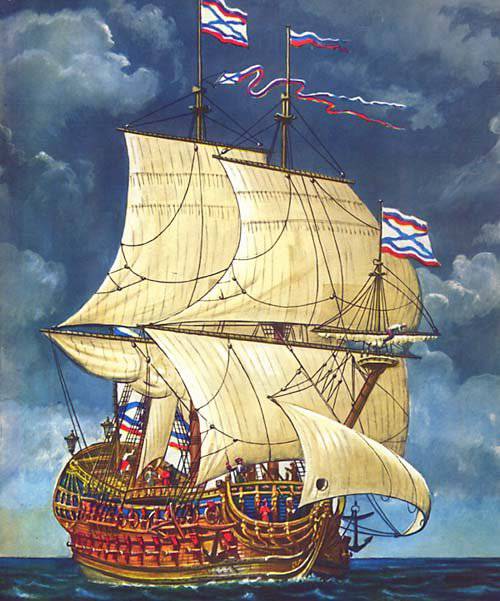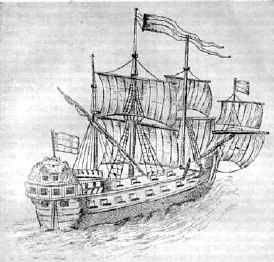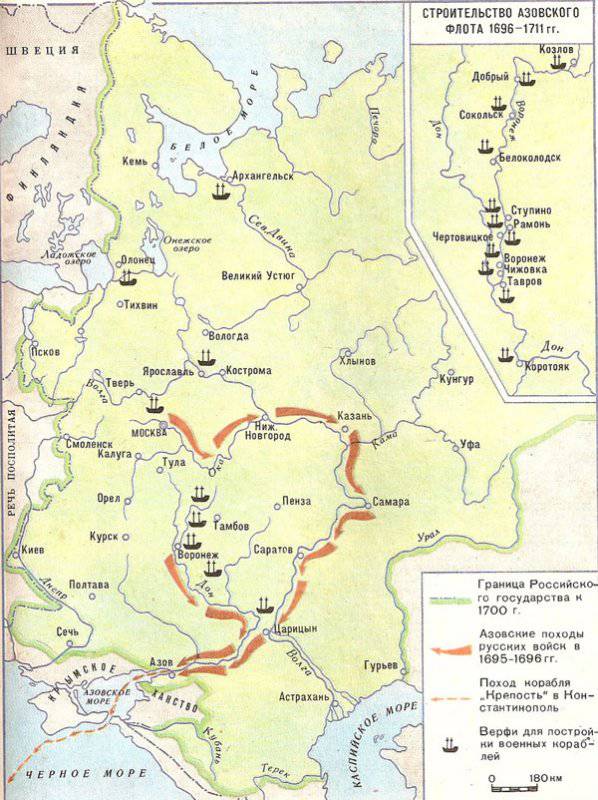"Ships to be ..."
In the fall of 1696, the question of construction fleet It was submitted to the Boyar Duma. On October 20, the Boyars' Duma adopted a decision: "To be sea vessels ...". It is clear that the construction of the fleet is a matter of state scale, of enormous complexity. It was necessary to create virtually a whole huge industry, build new shipyards, bases and ports, enterprises, workshops, ships, produce weapon. It was necessary to attract a huge number of artisans, workers, foreign specialists, to create a system for training maritime personnel — sailors, officers, gunners, etc. In addition to creating a production base, a maritime infrastructure, and a specialized education system, huge financial investments were needed.
Therefore, Tsar Peter I introduced a special ship service, which was extended to landowners, merchants, merchants. The duty included the supply of ships, fully prepared and armed. In the construction of the fleet were to take part all landowners who had over 100 peasant households. Secular landowners (estates of boyars and noblemen) were obliged to build one ship from every 10 thousand households (that is, together). Spiritual landowners (monasteries, the highest church hierarchy) were to be built by ship from 8 thousand courtyards. The merchants and merchants of Russia were to jointly lay and build 12 ships. Landowners who had less than 100 peasant households were exempted from construction, but were required to pay cash contributions - 50 kopecks from each yard. These funds are called "half the money".
It is clear that the ship's duty and the introduction of "half a ton of money" were met with hostility by many landowners and merchants. Some wealthy merchants and large landowners were even ready to pay off the conscription of the ship in order not to burden themselves with such a problem. But the king demanded the fulfillment of duties. When part of the merchants filed a petition asking "to dismiss them from the ship's business," they were punished by ordering two more ships to be built.
For the construction of ships, landowners were divided into “Kumpanism” (companies). Each company must build one ship and arm it. For example, the Trinity-Sergius Monastery, which had 24 thousand courtyards, was supposed to build the 3 ship. Smaller monasteries formed together for the formation of one Kumpanism. The secular kumpanstvo usually included 2-3 large landowner and 10-30 middle-aged nobles.
According to the original program, they planned to build 52 ships: 19 ships - secular landowners, 19 ships clergy and 14 ships - merchants. Kumpanism had to independently organize the whole complex of preparatory and construction work, including the maintenance of workers and craftsmen, the purchase of all materials, weapons. For the device shipyards were allocated places in Voronezh, Strupinskaya pier, in a number of settlements along the river Voronezh and Don.
Since the spring of 1697, shipbuilding has been in full swing. Thousands of people flocked to Voronezh and other localities where shipyards were established. As soon as one ship was lowered into the water, another was immediately laid. Not galleys were built, as during the preparation for the Second Azov campaign, but two- and three-masted warships with 25-40 guns on board. Voronezh has become a real “cradle” of the Peter fleet. With each passing year, the pace grew, without waiting for the construction of ships laid in the spring and summer of 1697, Peter ordered landowners and merchants to build additional 25 ships. By 1699, the construction of most ships was completed.
Disadvantages
This shipbuilding program revealed a number of serious shortcomings in the approaches. Some kumpanism did not rush to work, intending to evade duty or delay the delivery of ships. True, the king introduced harsh methods of punishment - for refusing to participate in the program he ordered to unsubscribe estates and patrimonies in favor of the treasury (to confiscate them).
Many landowners, in order to save or due to the lack of shipbuilding experience, were formal in their program (if only to do, without quality control). As a result, often did not pay attention to the choice of wood, other materials, the quality of work. The quality of construction was also affected by the abuse of contractors, the inexperience of a number of craftsmen.
As a result, the built ships quickly became dilapidated, demanded a lot of improvements, often rebuilding, repair. Peter’s hopes for foreign specialists, who had been invited to Russia since 1696, did not materialize. They were supposed to help in the organization of shipbuilding works and command the built ships. Only a part of foreign specialists justified the hopes placed on them, having rendered a great help in building and managing ships. A significant part of foreigners arrived in Russia for profits, having no experience in the ship case or poorly versed in this matter.
Ordinary sailors were completely powerless. A heavy burden fell on the serfs, on which the landowners laid the burden of conscription on the ships. They had to ensure the supply of everything necessary for the construction of ships, working to the detriment of agriculture and other occupations that provided their lives. Considerable losses were in horses - they were confiscated for transportation. As a result, the flight of people to the Don, Khoper, to other lands intensified.
Shipbuilding program changes
Based on the identified errors, the organization of shipbuilding works soon began to change. Abandoned the construction of ships Kumpanstvo. In September, 1698 of the year, some Kumpan agencies were allowed to make a cash ransom to the treasury instead of building on their own - 10 thousand rubles for a ship. Soon, this practice was extended to all Kumpanism. The funds received, as well as "half the money" launched a wider construction on state-owned shipyards.
Back in 1696, the Admiralty Yard was established in Voronezh. Already in 1697, the 7 of large ships and 60 brigantine were laid there (a small one-or two-masted sailing-rowing vessel for the carriage of goods and troops in coastal areas had 12-15 oars, a small-caliber 2-3 gun).
At the same time, the process of creating the foundations of the military organization of the fleet and its command and control was going on. In 1700, they established the "Order of the Admiralty Affairs", which was later transformed into the Admiralty Board. It was the central state authority for the management of the construction, supply and supply of the fleet. Admirals and officers were appointed to all important positions by royal decrees. The first head of the Admiralty, who was in charge of construction affairs, was the steward of A.P. Protasiev, then he was replaced by the Archangel voivode, one of the Tsar’s closest associates, Fedor Matveyevich Apraksin.
Russian masters, crew training
The best Russian craftsmen led the shipbuilding works, among them Fedosey Sklyaev (1672-1728) stood out among them. About him, the king said - "the best in his skill." Sklyaev was a native of Novgorod, served in the "amusing regiment" of Peter, participated as a carpenter in the construction on Lake Pereyaslav and in Voronezh. As a sailor of one of the galleys participated in the siege and capture of Azov. He was a member of the “Grand Embassy” 1697-1698, he worked in the shipyards of Holland, England, Venice. He became the chief master during the construction of the first battleship of Russia 58-gun "Goto Predestination" (in Latin means "God's Foresight"). This ship was highly appreciated by contemporaries and was launched on April 27 at the shipyard of the Voronezh Admiralty in the presence of senior government officials and foreign ambassadors personally Peter I. The ship was not only of good quality, but also an example of Russian applied decorative art. The king personally participated in the development of the drawings. God's Foresight was 1700 m long, 36 m wide, ship's depth was 9,5 m. The ship’s artillery consisted of guns mounted on two decks: on the bottom 3-pound caliber, on the top 16-pound and on the utah and tank - 8-pound. All guns were cast in Russia at the plants of Demidov.

Huge talent and excellent ability put forward Sklyaev among the founders of the Russian school of military shipbuilding. According to his projects and under the guidance of the master, more than 200 sailing and rowing vessels for the Sea of Azov, Baltic and White seas were launched. For success in technical improvement of ships and participation in the battles in the Baltic and in the Battle of Poltava F. Sklyaev was granted the title of captain-commander.
Together with Sklyaev in Voronezh, began their shipbuilding activities of the master Lukyan Alekseevich Vereshchagin (1672-1713), Gavril Avdeevich Menshikov (1672-1742). They, like Sklyaev, were sons of court grooms, sailors participated in the Azov campaigns, went abroad in the “Grand Embassy”. L. Vereshchagin, after participating in the work of the Voronezh shipyard, headed the forestry established by Peter, it was supposed to provide the shipbuilding industry with the best timber. G. Menshikov participated in the construction of dozens of different ships in Novaya Ladoga, Lodeynoye Pole, St. Petersburg Admiralty. They were also distinguished by their mastery: A. Molyarov — the “master of different arts”, M. Cherkasov, I. Nemtsov, A. Alatchaninov — were leading experts in the construction of the galley fleet. The masters of sailing, mast, rigging were S. Vasilyev, V. Korchlin, and others. M. Artemiev and G. Nikiforov were excellent anchor masters (for each ship from 2 to 10 anchors). Among the masters of cannon work stood out Navikatskoy mechanic school, "the king's personal turner" Andrei Nartov (1680-1756).
I must say that the king personally participated in the construction of ships as a carpenter, a shipwright. Peter deeply studied navigation, the theory of shipbuilding, other sciences and applied them in practice, did not shun "black" work.
The most important task was the manning of the fleet with sailors, training them in marine business. Initially, the crews took the soldiers of the infantry regiments, they were mainly trained by foreign officers. Gradually, the number of Russian specialists grew, and they introduced new elements of combat training, which were unknown to Europeans. Thus, foreigners were surprised to note that even in the winter in Voronezh they conducted combat training.
World with Turkey
The construction of the Azov fleet proceeded in a difficult international situation. Only in 1699, was it possible to conclude a truce for two years with the Ottoman Empire. During the truce they planned to work out the terms of a peace treaty. With this task, a diplomat Emelyan Ignatievich Ukraintsev was sent to Istanbul. He was an experienced diplomat, he served as Russian envoy in Sweden, Denmark, Holland, Turkey, Poland, was the head of the Ambassadorial Order. His embassy decided to send to the capital of the Turkish Empire by sea, to simultaneously demonstrate the power of the Russian Azov fleet.
 In the summer of 1699, Russian ships Scorpion, Dissolved Gates, Strength, Fortress, Good Connection and several galleys arrived from Azov to Taganrog. Ukrainians boarded the “Fortress”. It was a 46-gun three-mast ship built in 1699 at the Panshinsky shipyard. On August 14, the "sea caravan" of General-Admiral F. A. Golovin was removed from the anchor. The first campaign of the Azov fleet began. A total of 10 large ships were sent: 62-gun "Scorpion" under the flag of General Admiral Fyodor Golovin, "Good beginning" (Vice-Admiral K. Cruys holding the flag on it), "Color of War" (on it the Rear-Admiral flag held von Res), “Dissolved gates” (captain Peter Mikhailov), “Apostle Peter”, “Strength”, “Bezboyazn”, “Connection”, “Mercury”, “Fortress” (captain Peter von Pamburg).
In the summer of 1699, Russian ships Scorpion, Dissolved Gates, Strength, Fortress, Good Connection and several galleys arrived from Azov to Taganrog. Ukrainians boarded the “Fortress”. It was a 46-gun three-mast ship built in 1699 at the Panshinsky shipyard. On August 14, the "sea caravan" of General-Admiral F. A. Golovin was removed from the anchor. The first campaign of the Azov fleet began. A total of 10 large ships were sent: 62-gun "Scorpion" under the flag of General Admiral Fyodor Golovin, "Good beginning" (Vice-Admiral K. Cruys holding the flag on it), "Color of War" (on it the Rear-Admiral flag held von Res), “Dissolved gates” (captain Peter Mikhailov), “Apostle Peter”, “Strength”, “Bezboyazn”, “Connection”, “Mercury”, “Fortress” (captain Peter von Pamburg).Most of the squadron ships belonged to the barcalon class (from the Italian barca longa - three-masted ships with straight sails). They had a length of 33,5 — 36,6 m, a width of 7,6 — 9,1 m, and a draft — 2,1 — 2,4 m. They were armed with 26 — 44 guns. The barcalones were in many ways like galleas - large sailing-rowing vessels. Such a ship was the "Apostle Peter." "Scorpion" and "Fortress" created by the type of barbarian (barbarian) ships, i.e. according to the class of ships that were used in the 17th century by pirates of the northern coast of Africa, as well as by the Turks. These ships had a length of 30,5 — 38,1 m, 7,3 — 10,1 m, and a draft of 2,1 — 2,7. Sailing ships included three masts and a bowsprit; the foremast, the mainmast and the bowsprit carried straight sails, and the mizzenmast carried the oblique sail. Cannon armament 36 — 46 guns. All of these ships because of the relatively small rainfall could go into the shallow bays and estuaries.
In addition, the squadron included the Perinaya galleys and Rabbit Run (so named for speed) the royal yacht, 2-va galliot, 3-and brigantine and 4-e marine Cossack struga. Several hundred Don Cossacks led by ataman Frol Minaev went to them.
18 August near Kerch quite unexpectedly for the Turkish governor of the city and the commander of the Turkish squadron Admiral Hasan Pasha (Kerch had a Turkish squadron of 4 ships and several galleys) appeared Russian squadron ships. The deputy commander of the Russian squadron, Vice-Admiral Cornelius Cruys, described the impression that the arrival of the ships of the Azov fleet made to the Turkish commanders: “The Turkish horror could be seen from the face of this accidental visit with such a pretty armed squadron; and had a lot of work, so that the Turks believed that these ships in Russia were built and that they were Russian people. And as the Turks heard that His Majesty pointed out his ambassador on his own ships to Istanbul to take, then the Turks gave even more horror. ” It was a nasty surprise for the Turks.
The Turks initially refused to let the Russian embassy on the ship. But the Russian envoys were adamant. As a result, the Turks agreed with their plan, but asked that the Russian squadron quickly leave the waters of the Kerch Strait. 28 August, when the fair east wind "Fortress" blew out. Early in the morning of September 2, the Anatolian coast appeared, and in the morning of September 7 the Russian ship anchored in front of the Sultan's palace. The Russian embassy was located on the shore. And the ship became the object of close attention of Europeans and Turks. In Istanbul, they were stunned by the appearance of the Russian ship, and even more surprised was the news of the visit of Kerch to the Russian squadron. September 8 "Fortress" was examined outside by the Vizier, and the next day the Ottoman sultan himself did the same inspection.
Negotiations about the world were tense and long. Ambassadors of England and Holland tried to disrupt the negotiations. The Turks seemed to be willing to accept the fact that the Azov taken by the Russian troops and the entire area of the Don mouth would become part of the Russian state (initially they refused, demanding the return of all the lands), but insisted on the return of the Turkish outposts captured by the Russian army: Kazykermen , Tavani, Garslankermenya and Shangirei. A sharp negative reaction from the Turkish representatives was caused by the demand of the envoys of Russia to include in the peace treaty an article that would allow Russian merchant ships to sail across the Black Sea. The Turks said that the Port contains the Black Sea, "as if a pure and immaculate maiden and not only to have someone swimming on them, but she would never allow anyone to touch." Negotiations have been going on for almost a year. Peter hurried his envoy, agreeing to a significant concession, he needed peace on the southern frontiers, since he had already decided on a war with Sweden.
The peace treaty was signed in July 1700, its validity was determined on 30 years. Azov with the region (at a distance 10-hour horse ride) departed the Russian state. After Russia, the newly built towns remained - Taganrog, Pavlovsky Town, Miyus. In addition, Moscow was freed from the old custom - the payment of annual tribute ("gifts") to the Crimean Khanate. But it was not possible to agree on the free navigation of Russian ships in the Black Sea. Russia refused to claim Kerch. The Ottoman Empire returned part of the Dnieper region occupied by Russian troops with small Turkish fortified points, they were subject to immediate liquidation. Both sides pledged not to build new fortifications in the frontier zone, not to allow armed raids on each other. Istanbul was supposed to release Russian prisoners, as well as grant the Russian state the right to diplomatic representation in the capital of the Ottoman Empire on equal terms with other powers. The Treaty of Constantinople ensured Porte’s neutrality and allowed Peter I to enter the war with Sweden without fear for the southern frontiers.

Information